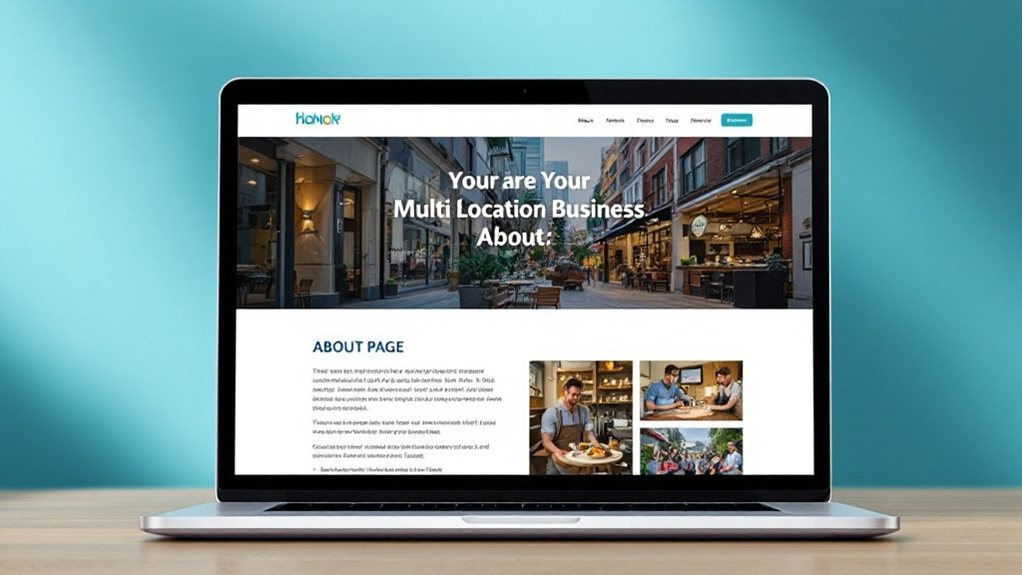As a multi-location business, you understand the importance of consistent branding and location-specific content to enhance user experience and build trust. By optimizing your About pages for search visibility, you can leverage local SEO strategies and showcase your unique selling points. Conducting thorough content research and continuous refinement are key to crafting effective local pages that resonate with your target audiences. Intrigued to learn more about the best practices for multi-location About pages?
Importance of Consistent Branding

When your business operates across multiple locations, maintaining consistent branding is crucial. Your core values, mission, and target audience must be clearly defined, ensuring alignment across all sites. Consistent visual elements, like your logo, colors, and typography, enhance brand recognition, while a unified tone of voice builds trust with your customers. Detailed brand guidelines act as a roadmap, specifying everything from asset management to communication style. Regular monitoring and adjustments keep your branding on track, empowering your team and driving customer loyalty. Consistent branding provides a competitive edge, boosts revenue, and fosters unity among your employees – all vital for the success of your multi-location business.
Incorporating Location-Specific Content

With consistent branding in place, you can now focus on incorporating location-specific content to further engage your local audiences. Leverage keyword research tools to discover relevant local terms, then weave them into your page titles, meta descriptions, and content. Ensure unique, original copy for each location, highlighting local attractions and services. Tie in local industry data to add credibility and relevance. Incorporate high-quality, location-specific visuals, such as exterior and interior photos to make the pages more engaging. Provide practical information like maps, directions, and operating hours to improve user experience. By tailoring your content to each location, you'll create a more personalized and engaging online presence.
Enhancing User Experience With About Pages

By providing an engaging and intuitive About page, you can effectively enhance the user experience for your multi-location business. Simplify the design, optimize for mobile, and implement intuitive navigation to make the page easy to navigate. Deliver relevant and engaging content, utilize social proof, and communicate clearly. Incorporate interactive elements, such as virtual tours or 360-degree videos, to engage users and showcase your locations. Optimize calls-to-action, and encourage user involvement to boost engagement. Ensure the page loads quickly, highlight data protection, and regularly conduct usability tests and A/B experiments. Monitor user feedback and iterate based on insights to continuously improve the About page experience.
Building Trust Through Business Values and History
Your About page is the perfect place to showcase your brand identity, highlight your founding principles, and emphasize your company's legacy and growth. Communicate your core values and how they've driven innovation and ethical decision-making within your organization. Leverage your business history to establish credibility, build an emotional connection with stakeholders, and convey your stability and reliability. Paying appropriate wages is a top trust-building issue, so highlighting your fair compensation practices can further demonstrate your commitment to ethical business.
Showcase Brand Identity
How do you effectively showcase your brand identity across multiple locations? Consistency is key – align your logos, signage, and marketing materials to build trust. Unify your brand messaging, tone, and values to enhance recognition. Visual branding guidelines maintain consistency in your visual identity. Align the customer experience to foster loyalty, even in different markets. Ensure your employees understand and communicate your brand identity effectively. These elements work together to showcase your brand identity cohesively, strengthening your presence and appeal to customers. Authenticity is also crucial – transparently share your brand purpose, operations, and community engagement to build trust.
Highlight Founding Principles
Establishing your business's founding principles and values is pivotal in building trust with potential customers. Highlight your commitments to community engagement, transparent practices, and ethical leadership. Showcase how your customer-centric approach and long-term dedication have shaped your brand identity.
Consider these strategies:
- Clearly articulate your core values, ensuring employees embody them.
- Regularly publish reports on social responsibility to reinforce accountability.
- Implement a robust customer feedback system to demonstrate commitment to continuous improvement.
- Evaluate steady cash flow to ensure financial stability and sustainability for future growth.
Emphasize Legacy and Growth
Alongside highlighting your founding principles, showcasing your business's legacy and growth strategies can powerfully build trust with potential customers. Demonstrate how your rich history and values-based leadership have driven consistent performance and innovation over time. High Performers are 17% more likely to invest highly in social media. Share data on your expansion plans and use of technology to manage growth. Highlight your focus on customer retention and local SEO to reach new markets. By transparently sharing your business's evolution, performance metrics, and community involvement, you'll convey a trustworthy, authentic brand that resonates with customers across your locations.
Optimizing About Pages for Search Engine Visibility
Your about page is a prime opportunity to optimize for search engine visibility. Craft keyword-driven content, structure your page logically, and localize your optimization efforts to reach more customers in each of your locations. Effective SEO leads to improved search engine visibility. By focusing on these key points, you can elevate your about page and boost your multi-location business's online presence.
Keyword-Driven Content
Because keyword research is crucial for optimizing your about pages for search engine visibility, you'll want to leverage tools like Google Keyword Planner, Google Trends, and MozBar. Keyword research is the foundation of any SEO strategy. Analyze your competitors' keywords to identify gaps and opportunities in local SEO. Focus on understanding user intent and regional variations, incorporating latent semantic indexing (LSI) keywords to enhance content relevance.
When integrating keywords, strategically place them in title tags, meta descriptions, and header tags. Ensure the keywords align with content purpose and maintain readability. Optimize multimedia elements like image alt tags and captions, while preserving the natural flow of your content.
- Create neighborhood-specific content to address unique local needs.
- Include location-based citations to boost credibility.
- Optimize technical SEO elements like title tags and internal linking.
Structured Organization
Effective organization of your website's structure is paramount for optimizing your about pages for search engine visibility. Establish a clear hierarchy, with logical URL structures and internal linking that connect related content. Site structure can strengthen aspects of the EEAT paradigm for Google. Leverage breadcrumbs to guide users, and maintain a single main website for multi-location businesses. Organize pages to highlight your services, using a pyramidal structure with key pages accessible within three clicks. Group relevant topics to build authority, and ensure unique content for each location to avoid penalties. Implement structured data and maintain consistent NAP to boost local visibility. A well-structured site enhances user navigation and search engine crawling, ultimately improving your about page rankings.
Localized Optimization
Optimizing your about pages for search engine visibility involves a multifaceted approach to localized content and technical optimization. Ensure each location page has unique, location-specific content that incorporates relevant keywords, entities, and micro-moments. Leverage technical SEO best practices, such as fast page speeds, clean URLs, and mobile-friendliness, to enhance user experience and search rankings.
Additionally, focus on user experience enhancements, including:
- Integrating interactive elements like social media links and contact forms.
- Showcasing local customer reviews to build social proof.
- Embedding Google Maps for easier location finding.
Structuring Location Landing Pages for Multi-Location Websites
Location landing pages serve as standalone pages for each physical location of a multi-location business. They are optimized to appear in local search results. Include essential information like business name, address, phone, and hours. Incorporate local keywords in URLs to boost visibility. Tailor content to highlight local attractions and experiences. For multi-location businesses, a centralized content management system is beneficial. Implement local schema to clarify page content for search engines. Include prominent CTAs to encourage conversions. Conduct local keyword research and enhance credibility signals. Use hyperlocal content to boost rankings. Showcase location-specific customer feedback and provide area-specific tips. Maintain a structured directory, integrate analytics, and conduct SEO audits for scalability.
Utilizing Local SEO Strategies for About Pages
As a multi-location business, you can't afford to overlook the importance of local SEO strategies when it comes to your About pages. Optimizing your Google Business Profiles, tailoring content to local markets, and building local authority are key.
For instance, you should:
- Incorporate location-specific keywords strategically.
- Highlight local partnerships, community involvement, and customer testimonials.
- Ensure consistency across all your location-based About pages.
Best Practices for Crafting Effective Local Pages
Creating effective local pages for your multi-location business requires optimizing for local search. Highlight the unique offerings and services at each location to provide value to your customers. Leveraging best practices like targeted keywords, local business listings, and tailored content can boost your visibility and credibility.
Optimize for Local Search
Optimizing for local search is crucial for multi-location businesses, as it ensures your webpages are tailored to target the specific communities you serve. To achieve this, focus on the following strategies:
- Create location-specific landing pages with targeted content, geographic keywords, and unique information about each location.
- Leverage local directories and citations to build credibility and improve visibility across various platforms.
- Conduct competitor research to identify gaps and opportunities, then tailor your content and keyword strategies accordingly.
Highlight Unique Offerings
When crafting effective location pages, it's crucial to highlight your unique offerings that cater to the specific needs and preferences of the local community. Feature local events and promotions to enhance appeal, and incorporate community engagement to build credibility. Emphasize local partnerships and use authentic imagery and testimonials to demonstrate your commitment to the area. Offer location-specific services tailored to the unique requirements of each market. By leveraging these strategies, you can create a compelling local presence that resonates with your target audience and sets your business apart from the competition.
Showcasing Unique Selling Points on Location Pages
Consistently showcasing your business's unique selling points (USPs) on location pages can be a powerful strategy to differentiate your brand and attract potential customers. By highlighting what makes your offerings distinct, you can enhance your value proposition and drive conversions. Consider these three ways to effectively integrate USPs on your location pages:
- Craft compelling ad copy that clearly communicates your USPs, using keyword-rich language to improve relevance.
- Ensure your location page content and visuals reinforce the unique benefits you provide, creating a cohesive brand experience.
- Continuously test and refine your USP messaging across different marketing channels to optimize performance.
Conducting Content Research and Continuous Refinement
Conducting thorough content research is the foundation for crafting compelling About pages that resonate with your target audience. Analyze user behavior, identify competitors, and leverage keyword tools to understand your market. Gather relevant data from industry reports, customer reviews, and online forums to inform your content. Ensure relevance by focusing on user intent, planning regular updates, and optimizing for local SEO. Establish feedback mechanisms, test new content, and monitor performance to continuously refine your About pages. Leverage technology like content management systems, automation tools, and SEO audits to streamline your research and refinement process.
